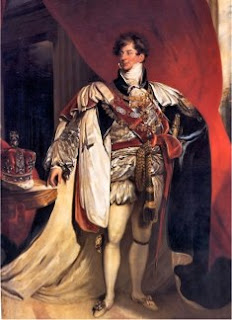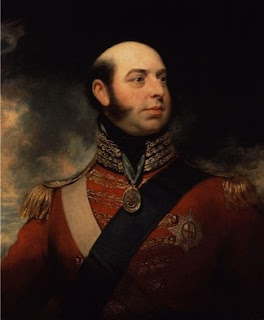 |
| George III |
And then Victoria came to the throne. The daughter of the fourth son of George III.
George III had 9 sons, though, two dying in infancy, Octavius and Alfred. Of the other seven, four had mistresses that were of very long duration. These mistresses and the marriages are worth examining.
Only four though are we concerned with, of the seven which grew to adulthood.
Of those seven, four maintained long relationships with women whom they so cherished and with whom they consorted that the ladies were as wives to them. George, Frederick, William, and Edward had relationships that were of such strength, or in fact were marriages, that the women cannot be ignored.
And if by example, or by coincidence so many of the first circle of the Ton also carried on affairs, these royals' relationships need to be examined. We can’t ignore it in our Regencies. To forget that one of the Princes was really shacked up with one of these ladies would put our tales out of the context of the times.
So we need take a look at our Princes and their mistresses.
George IV
 |
| George IV |
We all should know that Geroge did not like the bride he took to secure the payments of his debts (600,000 pounds or about 1.2 billion in todays reckoning) and achieve the allowance he desired, a woman to whom he was only dedicated for a few short years until the birth of his beloved Charlotte. Three days after which he wrote a new will giving all to Mrs. Fitzherbert.
For over 30 years Mrs Fitzherbert and the Prince were together, and when asked directly if she had ever had children of the Prince and King, she coyly changed the topic of conversation to something else. And never would she sign a statement saying she had not had children.
 |
| Maria Fitzherbert |
She married George, Prince of Wales at the time, on December 15, 1785. George paid the debts of Reverend Robert Burt to get him out of the Fleet Prison to perform the ceremony. It was not a legal marriage for the marriages act of 1772 forbade George to marry without the approval of the King and his Privy Council. If it had been legal, George would never have become king. So an interesting conundrum. But it did mean that the two acted as if they were married for a number of years.
 |
| Princess Caroline of Brunswick-Wolfenbütte |
William IV, finding the truth in the assertions of the marriage, offered to make Mrs. Fitzherbert a Duchess, but instead she just asked to wear widows’s weeds and dress the servants in royal livery. She died in 1837.
His mistress was Mary Anne Clarke from 1803 to sometime between 1809 and 1811; he then married Princess Frederica of Prussia.
 |
| Mary Anne Clarke |
 |
| Princess Frederica of Prussia |
But then the money must have grown on trees. The Duke cut all ties to the woman, though he paid her a large sum of money so she would not publish letters he had written her. Then, when he was exonerated, he was reinstated as Commander-in-Chief of the army by the Prince Regent, his elder brother.
Mary Anne was later tried for libel and imprisoned. Her daughter by the Stonemason would marry Louis-Mathurin Busson du Maurier. Her grandson was the caricaturist George du Maruier and great-granddaughter was Daphne du Maurier.
His mistress, Dorothea Jordan who he lived with for twenty years and gave him ten children. He then married Adelaide of Saxe-Meiningen.
This is my favorite of the mistresses for with ten children, this was a true marriage between successful people. Dorothea Bland was the daughter of stagehand and an actress, theater people, and when thirteen, her father left her mother and four other siblings for another actress.
 |
| Dorothea Jordan |
Then in England, she had an affair with an army Lieutenant named Charles Doyne. He proposed but she went to work for the theater company operated by Tate Wilkinson. This is when she took the name Mrs. Jordan. After Wilkinson, she had an affair with George Inchbald. She would have married Inchbald, but he did not ask. In 1786, she began an affair with Sir Richard Ford, who promised to marry her. They had three children together. When she realized that Ford was never going to wed her, she traded up to William.
She began her affair with William in 1791 and moved in with him at Bushy House.
 |
| Bushy House |
 |
| Adelaide of Saxe-Meiningen |
Now broke, she fled to France in 1815 and died a year later in poverty. Her descendants include many of the famous. One is David Cameron, Prime Minister of the United Kingdom as of this posting.
His mistress for twenty-eight years was Julie de St. Laurent, until he then married 1818, Princess Victoria of Saxe-Coburg-Saalfeld, who became the mother of Queen Victoria.
 |
| Julie de St. Laurent |
 |
| Princess Victoria of Saxe-Coburg-Saalfeld |
The circumstances of the Duke of Kent and his mistress provide perhaps the best material should a writer wish to turn the Regency on its head with a fantasy. Their first son is rumored to have been born in 1793 and the second in 1794. When Prinny assumed the throne as Regent in 1811, the boys would have been eighteen and seventeen. Or when he came to the throne in his own right in 1820, twenty-seven and twenty-six. Young men!
While doing research I came across paintings of the other sons and their wives:
Ernest Augustus
Ernest Augustus
 Mr.
Wilkin writes Regency Historicals and Romances, Ruritanian (A great
sub-genre that is fun to explore) and Edwardian Romances, Science
Fiction and Fantasy works. He is the author of the very successful
Pride & Prejudice continuation; Colonel Fitzwilliam’s Correspondence. He has several other novels set in Regency England including The End of the World and The Shattered Mirror. His most recent work is the humorous spoof; Jane Austen and Ghosts.
Mr.
Wilkin writes Regency Historicals and Romances, Ruritanian (A great
sub-genre that is fun to explore) and Edwardian Romances, Science
Fiction and Fantasy works. He is the author of the very successful
Pride & Prejudice continuation; Colonel Fitzwilliam’s Correspondence. He has several other novels set in Regency England including The End of the World and The Shattered Mirror. His most recent work is the humorous spoof; Jane Austen and Ghosts. The
links for all locations selling Mr. Wilkin's work can be found at the
webpage and will point you to your favorite internet bookstore: David’s Books, and at various Internet and realworld bookstores including the iBookstore, Amazon, Barnes and Noble, Smashwords.
The
links for all locations selling Mr. Wilkin's work can be found at the
webpage and will point you to your favorite internet bookstore: David’s Books, and at various Internet and realworld bookstores including the iBookstore, Amazon, Barnes and Noble, Smashwords.
You also may follow Mr. Wilkin on Twitter at @DWWilkin
Mr. Wilkin maintains a Pinterest page with pictures and links to all the Regency Research he uncovers at Pinterest Regency-Era










Most enjoyable and informative. Thank you.
ReplyDeleteGreat post! Thank you for my new word "Ruritanian"
ReplyDelete